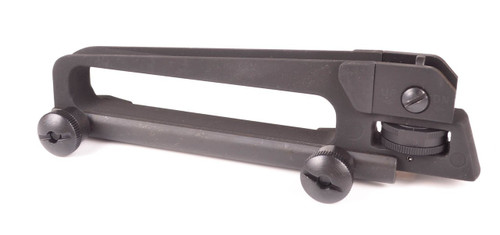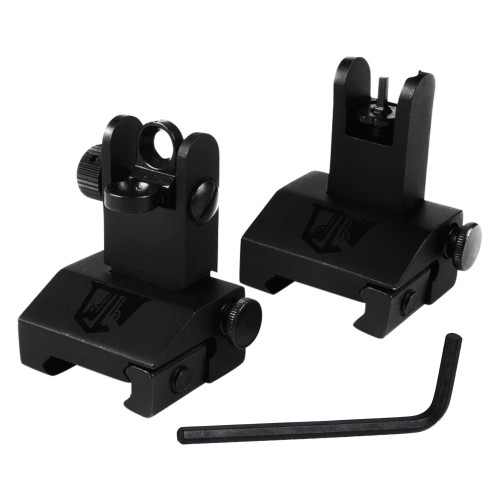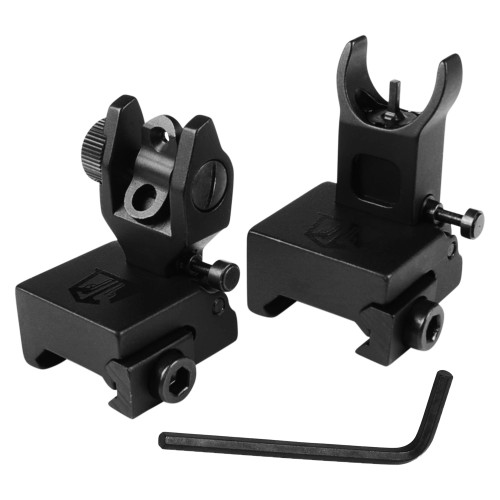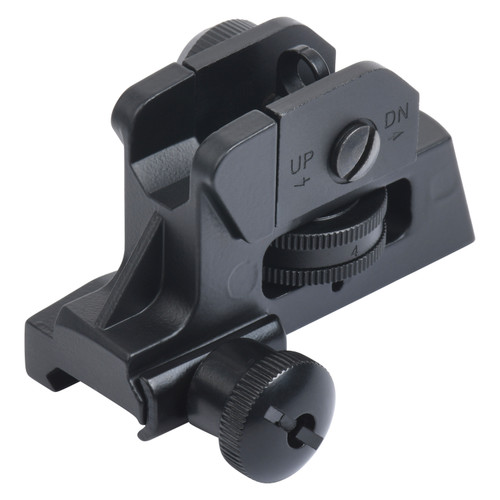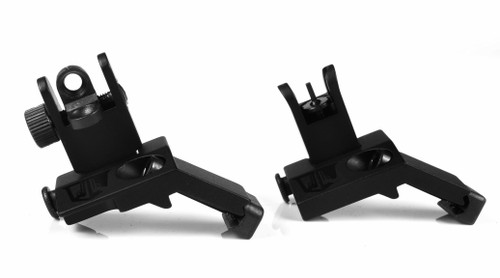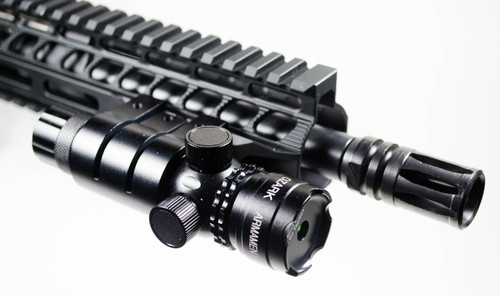Posted by Matt Rice on Feb 12th 2024
Mastering Precision: A Guide to Adjusting AR 15 Iron Sights for Accurate Shooting

Adjusting AR-15 iron sights might seem daunting at first, but it's a crucial skill for any rifle enthusiast. Whether you're hitting the range for some target practice or prepping for a competition, knowing how to fine-tune your sights can make all the difference. In this guide, I'll walk you through the essentials of adjusting your AR-15 iron sights, from understanding the types you might have to the precise adjustments needed for that perfect shot. With a blend of technical know-how and practical tips, you'll be setting your sights with confidence in no time.
Key Takeaways
- Types of AR-15 Iron Sights: A variety of iron sights are available for the AR-15, including the A2 Carry Handle Rear Sight, Battle Sights (BUIS), 45 Degree Flip Up Backup Sights, Micro Flip Up Backup Sights, Fixed Canted Iron Sights, and the A2 Front Sight. Each type serves a different purpose and requires a specific approach to adjustment for optimal accuracy.
- Importance of Sight Picture: Achieving an accurate sight picture, where the front sight is in clear focus against a slightly blurred target and rear sight, is crucial for precision shooting. This fundamental skill enhances the shooter's ability to make necessary adjustments accurately.
- Adjusting Elevation and Windage: Proper adjustment of windage (horizontal) and elevation (vertical) is key to aligning the point of aim with the point of impact. This involves using the adjustment knobs on the iron sights, with each click translating to a specific change in the point of impact, typically measured in Minutes of Angle (MOA).
- Proper Sight Alignment: Ensuring that the front and rear sights are properly aligned with each other and the target is critical for achieving pinpoint accuracy. This requires understanding the unique adjustment mechanisms of different types of AR-15 iron sights.
- Testing and Fine-Tuning: After making any adjustments to the iron sights, it's essential to test fire the AR-15 and observe the impact of adjustments. Fine-tuning involves making additional adjustments based on shooting results to achieve the desired accuracy.
- Empowerment through Self-Adjustment: While professional services are available, learning to adjust your AR-15 iron sights empowers shooters to make precise adjustments on their own, leading to improved shooting accuracy and a better understanding of their firearm.
Types of AR-15 Iron Sights
When it comes to adjusting AR-15 iron sights, understanding the types I've got on my rifle is crucial. These sights vary in design and purpose, influencing how one goes about adjusting them for an accurate shot. In my experience, and looking closer at products from Ozark Armament, several types stand out for their versatility and reliability.
Firstly, the Carry Handle Rear Sight is a classic. It’s built into the carry handle of some AR-15 models, offering a durable and reliable sighting system. Its traditional design means sighting in AR iron sights like these relies on proven methods that have been around for years.
The Battle Sights, or Back-Up Iron Sights (BUIS), are indispensable for their role as a fail-safe. Particularly, the HK Style BUIS and A2 Rear Iron Sight, offer robust solutions for quick target acquisition. The convenience of having a backup when optics fail cannot be understated and adjusting AR iron sights like these can be learned with some practice.
For those looking for modernity and ease of use, 45 Degree Flip Up Backup Sights and Micro Flip Up Backup Sights are game-changers. These sights are designed for rapid deployment, allowing shooters to seamlessly switch between optics and iron sights without losing focus. Their compact design demands precision when adjusting iron sights on AR 15, making each click of the adjustment knob critical to landing that perfect shot.
Finally, there's the Fixed Canted Iron Sights and the dependable A2 Front Sight. The canted sights are a unique addition, providing an angled sighting option that's perfect for shooters engaging targets at various distances. Adjusting these sights requires understanding their angle in relation to standard sighting. When it comes to the A2 Front Sight, mastering how to zero A2 iron sights is a skill every AR-15 owner should know.
For those curious about how to adjust Feyachi iron sights or about iron sights for Noveske, while my focus here has been on Ozark Armament’s lineup, the principles of adjustment remain much the same. Each click of the sight adjustment moves the point of impact by a certain amount, typically measured in Minutes of Angle (MOA).
Understanding Sight Picture
When I'm out on the range or discussing tactics with fellow enthusiasts, the conversation often turns to the importance of a proper sight picture in achieving accurate shooting. For those new to the game or seasoned shooters looking to revisit the basics, understanding and adjusting your AR-15 iron sights are fundamental skills that can drastically improve your shooting accuracy.
The sight picture encompasses how your front and rear sights align with each other and the target. Achieving a perfect sight picture means aligning your sights in such a way that your eye naturally focuses on the front sight, keeping it crisply in view while the rear sight and the target are slightly blurred. This technique ensures that when you're adjusting your AR-15 iron sights or sighting in your AR15 iron sights, you're doing so with precision.
For those of us using AR-15s, the array of iron sights from Ozark Armament offers a robust solution for enhancing sight picture clarity. Whether it's the Carry Handle Rear Sight for a classic look and feel, the Micro Flip Up Backup Sights for compact efficiency, or the versatile 45 Degree Flip Up Backup Sights that allow for seamless transitions between optics and iron sights, there's a fit for every shooter's need.
Adjusting these sights, whether you're zeroing in at the range or making field adjustments, follows a straightforward process. The key lies in understanding the mechanics of your specific sight. For example, how to zero A2 iron sights involves understanding the adjustments for windage and elevation that are unique to that style. Information on adjustments can be found in the product manuals or through reputable resources online.
Here's a quick highlight on how to adjust AR15 iron sights, particularly useful for models like the A2 Rear Iron Sight or the Fixed Canted Iron Sights:
- Elevation Adjustments: Often made on the front sight, changing the point of impact up or down.
- Windage Adjustments: Typically done on the rear sight to move the point of impact left or right.
The Importance of Proper Sight Alignment
When it comes to adjusting AR 15 iron sights, the goal is always pinpoint accuracy. Whether I'm at the range or in a competitive setting, the clarity and precision of my sight picture directly influence my performance. That's why understanding the mechanics of sighting in AR15 iron sights is crucial.
First off, it's essential to know that there are various types of AR 15 iron sights, each with its unique adjustment mechanisms. From the versatile Carry Handle Rear Sight to the precise A2 Rear Iron Sight, and the practical Micro Flip Up Backup Sights, choosing the right type and properly aligning it can significantly improve shooting accuracy. For those in harsher or more demanding environments, the HK Style BUIS and Battle Sights (BUIS) offer robust options. Meanwhile, the 45 Degree Flip Up Backup Sights and Fixed Canted Iron Sights provide exceptional alternatives for situations requiring quick target acquisition from an offset angle.
Adjusting AR iron sights might seem daunting at first, but it's all about understanding the fundamentals. The principal elements involve windage and elevation adjustments, which align the point of aim with the point of impact. How to zero A2 iron sights, for instance, involves specific steps that can be mastered with practice. The National Shooting Sports Foundation is a reliable resource that offers in-depth guides on this topic.
For those unfamiliar with how to adjust Feyachi iron sights or any AR-style sights, it's advisable to start with the basics of aligning the front and rear sights to ensure they're on the same horizontal and vertical plane as the target. If the process feels overwhelming, remember, many online resources and forums exist to help. One such resource is AR15.com, where enthusiasts and experts alike share their knowledge on sighting in AR iron sights.
Adjusting Elevation
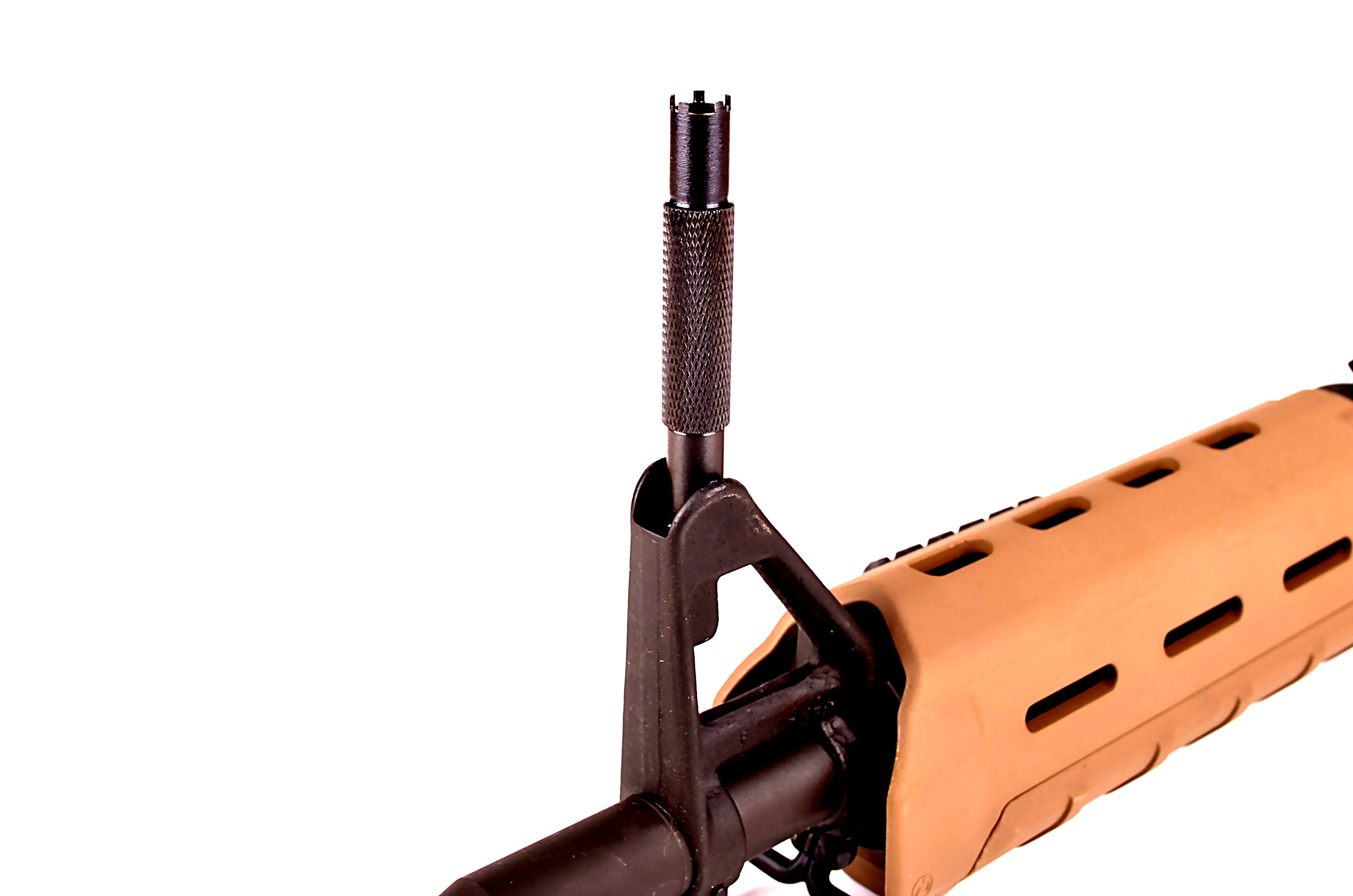 When it comes to sighting in AR iron sights, understanding the intricacies of adjusting elevation can significantly enhance your shooting accuracy. Whether you're a seasoned shooter or just starting out, mastering this skill is essential. Here's a clear breakdown on how to fine-tune the elevation settings on your AR-15 iron sights, including those from Ozark Armament.
When it comes to sighting in AR iron sights, understanding the intricacies of adjusting elevation can significantly enhance your shooting accuracy. Whether you're a seasoned shooter or just starting out, mastering this skill is essential. Here's a clear breakdown on how to fine-tune the elevation settings on your AR-15 iron sights, including those from Ozark Armament.
First off, establishing a stable shooting platform is crucial for accurate adjustments. I always ensure my rifle is securely rested on a bench or supported by sandbags. This setup minimizes movement and helps in achieving consistent shot placements. For those new to adjusting AR15 iron sights, remember, the goal here is precision.
Adjusting the elevation begins with identifying which sight needs tweaking. If it's the front sight, like the A2 Front Sight, you'll need to move the post either up or down. It's important to remember, the adjustments are counterintuitive; lowering the front sight post raises the bullet's impact point on the target, and vice versa. Since not all front sights are adjustable, in some cases, you'll shift focus to the rear sight for elevation adjustments.
For rear sights, including options like the Carry Handle Rear Sight or A2 Rear Iron Sight, the process involves using an elevation dial. The rule of thumb is pretty straightforward—if you're hitting above the desired point of aim, dial the sight down. Conversely, if you're hitting too low, dial it up. This method directly moves the point of impact in the direction you adjust the sight.
Once adjustments are made, it's paramount to test and retest. I typically fire three-round groups to gauge the impact of my adjustments. This iterative process ensures the sights are dialed in perfectly before finalizing any settings. For newcomers struggling with this process, checking out forums such as AR15.com or resources provided by the National Shooting Sports Foundation can be incredibly helpful.
Even though Ozark Armament offers various iron sights, like the Micro Flip Up Backup Sights or 45 Degree Flip Up Backup Sights, understanding how to adjust them is universally applicable. Whether you're sighting in AR iron sights for the first time or tweaking your setup for optimal performance, these basics hold true across different models and manufacturers.
Adjusting Windage
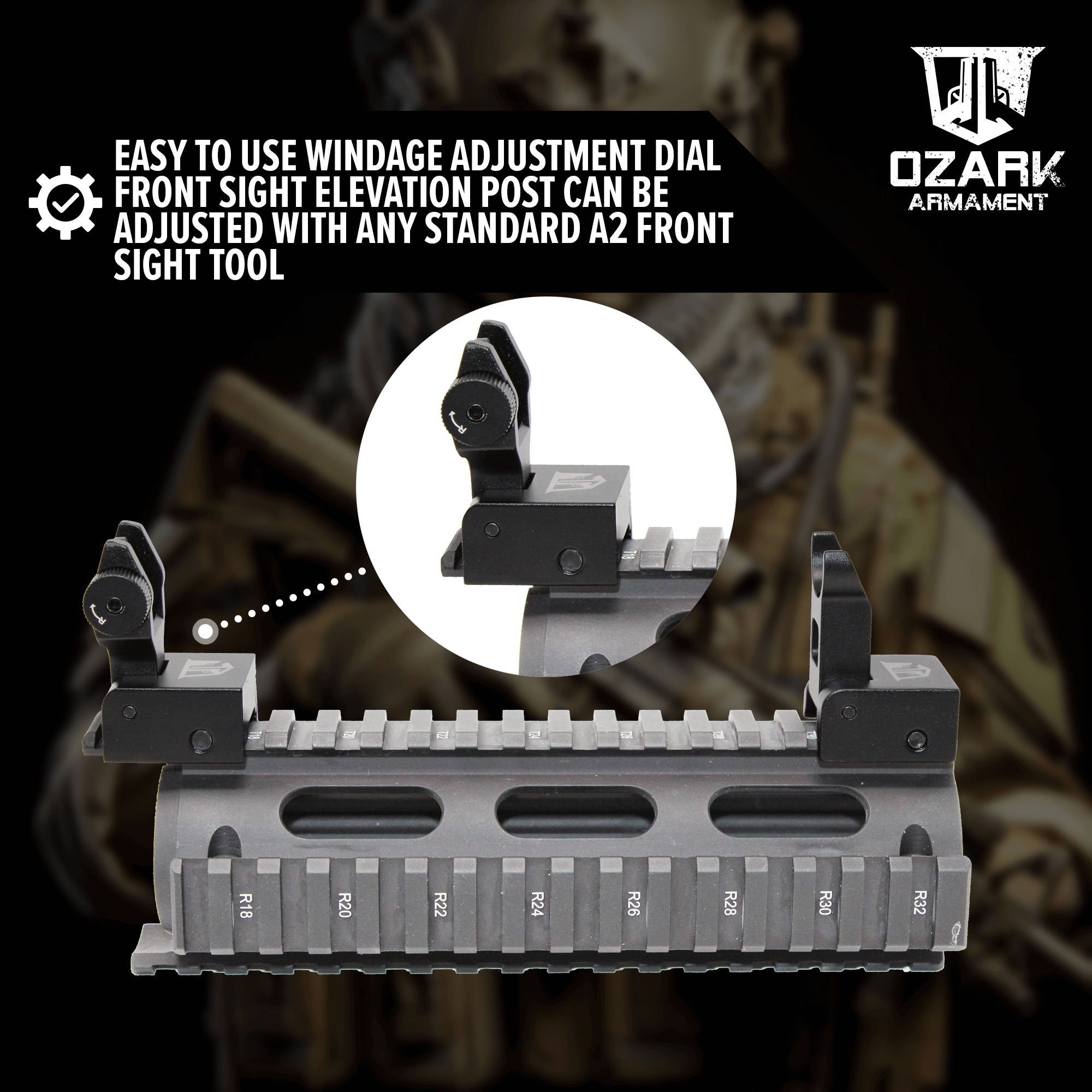
When it comes to adjusting AR 15 iron sights, understanding the nuances of windage adjustments can make all the difference in achieving that perfect shot. I've found myself on many occasions tweaking my AR's sights to get the accuracy just right. Windage, essentially, refers to the horizontal adjustment of your sights. This adjustment ensures your shots land exactly where you're aiming, compensating for any left or right drift.
For those new to adjusting iron sights on an AR 15, the process might seem daunting. But, the key lies in the rear sight. By turning the windage knob on your rear sight, you can shift the point of impact either left or right. It's crucial to remember, each click of the knob translates to a specific change in point of impact at a set distance, typically measured in MOA (Minutes of Angle). I highly recommend consulting your sight's manual for the exact values, but a general rule of thumb is moving the rear sight in the direction you want the bullet to hit.
The Ozark Armament Resources section is a fantastic depository for diving deeper into the mechanics of AR 15 iron sights adjustments. Whether you're installing Micro Flip Up Backup Sights or trying to zero A2 iron sights, their guides are incredibly detailed and user-friendly.
Testing is as important as the adjustment itself. After making your adjustments, it's wise to shoot another group to check the results. If your shots aren't hitting the mark, don't hesitate to repeat the process, making fine adjustments. I always use grid paper targets for this. Documenting adjustments and results not only helps in achieving that perfect zero but also improves my shooting skills over time.
If you're venturing into adjusting AR iron sights for the first time or you're an experienced shooter tuning your Carry Handle Rear Sight or HK Style BUIS, remember, patience and practice are your best tools. And while Ozark Armament offers a range of sights like the Fixed Canted Iron Sights or the 45 Degree Flip Up Backup Sights, the principles of windage adjustments I've shared here are universally applicable.
Fine-Tuning for Precision
When it comes to adjusting AR 15 iron sights, precision is key. I've always stressed the importance of ensuring every shot counts, and fine-tuning your AR iron sights is an essential step in achieving that pinpoint accuracy. Aligning the sights properly isn't just about making the gun look right; it's about enhancing its performance to hit the target every time.
For shooters aiming to perfect their shots, understanding how to adjust the windage and elevation of your AR 15 iron sights is crucial. Windage adjustments are made to shift the point of impact left or right, while elevation adjustments will move the point of impact up or down. This is where acquiring quality iron sights, such as those from Ozark Armament, becomes invaluable. Their models like the Carry Handle Rear Sight or the versatile 45 Degree Flip Up Backup Sights offer sturdy and reliable options for any AR 15 enthusiast.
Adjusting iron sights on an AR 15 involves a few critical steps. Firstly, ensure your rifle is unloaded for safety. Then, depending on the model of your iron sights, use the appropriate tools to make small adjustments. For example, how to zero A2 iron sights involves using a bullet tip to turn the elevation knob until you've aligned the sight for the correct distance.
An example of precision tuning can be found in adjustments based on distance and impact discrepancy. With a sight radius of 26.25 inches and an impact 5.3 inches too high at 50 yards, adjusting the front sight height is essential. Fine-tuning in such detail ensures your AR 15 performs as expected in various conditions.
Whether it's for competition, hunting, or defense, selecting the right iron sights and knowing how to install iron sights on an AR 15, such as the A2 Front Sight or Fixed Canted Iron Sights, plays a pivotal role in your shooting accuracy. While some might prefer sighting in AR 15 iron sights using professional services, I believe in the empowerment and satisfaction of adjusting your own. Following a thorough process and making educated adjustments will significantly improve your AR 15's accuracy.
Wrapping Up
Mastering the art of adjusting AR-15 iron sights is a game-changer for any shooter aiming for precision and accuracy. With the right knowledge and tools, I've shown that fine-tuning your sights—whether it's the Carry Handle Rear Sight or the more modern Micro Flip Ups—can significantly enhance your shooting experience. It's not just about making adjustments; it's about understanding the mechanics behind your sights and applying that knowledge on the range. The satisfaction of hitting your target with accuracy you've dialed in yourself is unmatched. Remember, practice makes perfect, and with each adjustment, you're not just tweaking your sights, you're honing your skills as a marksman. So take your time, refer to those manuals, and don't shy away from seeking out additional resources when needed. Your AR-15 is an extension of yourself—make sure it's as precise as you are.
Frequently Asked Questions
What is the basic rule for sight adjustment?
The fundamental rule for sight adjustment is to align your sights in the direction you wish your shots to move. If your shots are high and to the left, you should adjust your rear sight down and to the right to correct this.
What requires the correct alignment of target, front sight, and rear sight?
Accurate shooting mandates the correct alignment, known as sight picture or sight alignment, involving the target, front sight, and rear sight. The front sight must be centered within the rear sight, both of which should be in line with the target for precision shooting.
How do you adjust the iron sight on an AR-15?
Adjusting the iron sight on an AR-15 involves simple steps. For elevation adjustments, press down the button at the front of the sight and turn it using a suitable tool. To adjust windage, manipulate the rear sight’s windage knob to move the point of impact left or right as needed.
Are iron sights always accurate?
Iron sights, in terms of mechanical accuracy, can be exceedingly precise. Any inaccuracies are generally due to shooter error. With proper technique, hitting a target at significant distances, like 300 meters, is feasible with iron sights.
Should I put iron sights on AR-15?
Including a set of iron sights, whether stock or aftermarket, on your AR-15 is highly recommended. Regular practice with them enhances proficiency and provides a reliable backup. Additionally, it offers a fun challenge and a way to test true shooting skills at the range.
ARTICLE WRITTEN BY MATT RICE, OWNER OPERATOR OF OZARK ARMAMENT

